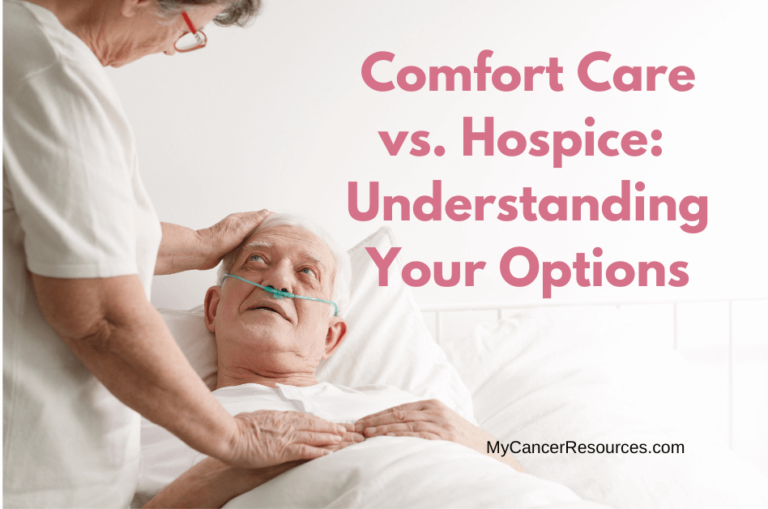
During cancer treatment, you might hear about different types of care that are available, including palliative care (also known as comfort care) and hospice care. This guide compares comfort care vs. hospice care.
I’m a big fan of palliative care. I know firsthand how these ‘wraparound services’ really help patients and families.
I helped my mother-in-law get palliative care services, and when there were no more treatment options for her cancer, I worked with her to get hospice services set up.
We worked closely with the hospice team for the last 3 months of her life to make sure she was comfortable and could focus on what was important to her. She wanted to live long enough to reach her 50th wedding anniversary (which she did) and to have more time with her family.
Both palliative care/comfort care and hospice care truly support the patient and their caregivers. I wish that these services were available worldwide to everyone facing cancer.
I hope this information helps you to decide which type of care might be the right choice for you.
This guide is meant to help you make informed choices that prioritize comfort, dignity, and the best possible quality of life.
A Quick Comparison: Comfort Care vs. Hospice
Palliative care works to improve your quality of life by managing symptoms and providing emotional support.
It’s not just about treating the disease; it’s about treating you as a whole person.
On the other hand, hospice care is for those in the final stages of life. Hospice care focuses on comfort, dignity, emotional and spiritual support when a cure is not possible.
Palliative Care: A Compassionate Approach
Comfort care can start at any time. Many experts, including the World Health Organization and the National Hospice and Palliative Care Organization recommend that palliative care be started at diagnosis for life-limiting or life-threatening conditions, like cancer.
How Does Comfort Care Help?
Palliative care patients get an extra layer of support alongside active treatments like chemotherapy, radiation, immunotherapy or surgery.
Palliative care balances managing the disease and improving the patient’s quality of life. Services are tailored to meet the unique needs of each patient.
My mother-in-law had anaplastic meningioma, a rare, hard to diagnose type of cancer. It took her over a year to get a diagnosis. Unfortunately, it’s also a very fast-growing type of cancer. She had multiple surgeries before trying chemotherapy, radiation and immunotherapy, but nothing was effective.
The palliative care team coordinated with her primary medical team and her oncology team to make sure everyone knew what was going on and what the current plan of care was.
She was in a lot of pain from the tumors in her spine. It was hard for her to sit, stand, or walk comfortably. Her palliative care team made sure her symptom relief, including pain relief, was covered, that the meds she needed so badly didn’t fall through the cracks with so many doctors trying to care for her.
Her palliative care specialist, working with palliative doctors on her interdisciplinary team watched her case at a high level, making sure to keep pain and other side effects/symptoms under control.
Her primary doctor was more focused on day-to-day health concerns like her asthma, and her oncologists were focused on the type of treatment she was having at that moment.
It was a relief knowing that someone was looking over everything that she was being treated for and touching base with her to make sure her care plan was meeting all her needs and that she didn’t have any symptoms that weren’t being addressed.
Where are Palliative Care Services Received?
Most of the time, we saw the palliative care team at treatment or follow up visits. We didn’t have to make special appointments to see them – they popped in during her regularly scheduled appointments, which was a relief not to have to schedule one more thing. We also got phone calls checking in on her and referring her to other supportive services when needed.
Palliative care also taught my father-in-law and other family members relaxation and breathing techniques we could use to help her relax when she wasn’t able to sleep.
Hospice: Providing Comfort and Support in the Final Stages
Hospice care is another type of supportive care, but this is specifically for people nearing their final stage of an illness, who typically have six months or less to live.
A primary goal of hospice care is to relieve suffering and ensure that patients live out their final days with dignity, comfort, and minimal pain.
How Does Hospice Help?
Hospice comes in when treatments to cure the disease have ended.
My mother-in-law, Darlene, knew she wanted to spend her final days at home, and not in a hospital. So when her oncologist told us that there were no other treatment options available, we immediately asked for hospice.
Hospice care is provided by a team of specialists including nurses, social workers, chaplains and home health aides who work together to provide total support. Services are overseen by a medical director.
Hospice patients typically stop seeing all other medical providers and hospice takes over all care during regular visits, including prescribing all medications.
Hospice can also provide medical equipment. My mother in law had a walker and then a wheelchair provided by hospice. They also provided a hospital bed, and medical supplies including mouth swabs, special mattresses and pads for bed sores, and catheter supplies.
While nurses and home health aides tended to her medical care, social workers talked with her about any last wishes she had, and her thoughts and emotions about nearing the end of life. The chaplain helped her walk through the steps of deciding what she wanted her visitation and funeral to look like.
The hospice team also explained to us what it would look like the closer she got to death.
Even though I knew this information, it was helpful for the rest of the family to hear about it from someone else, someone removed from the emotion of it all.
After Darlene died, the hospice program offered bereavement (grief support) services for everyone in her family – her husband, son, me, her grandkids, sisters and extended family. This was very helpful, because with something like cancer, grief begins before death, and extends long after your loved one is gone.
The biggest blessing of hospice was allowing Darlene to have her pain controlled and to receive support and care from the comfort of her home, providing quality time with her family, which is exactly what she wanted.
Where are Hospice Services Received?
Hospice programs can be provided in the hospital on a dedicated hospice unit, in a nursing home, in home-like hospice residences, or in the patient’s home.
In-home hospice care is the most common type of hospice care, since many prefer to be surrounded by their loved ones in a comfortable, familiar place when they die.
Similarities Between Palliative Care and Hospice
Shared Goals
At their core, both palliative/comfort care and hospice share a common goal: to improve the quality of life for individuals facing serious illnesses, including cancer.
Whether it’s managing symptoms, easing pain, or providing emotional support, the primary focus is always on the patient’s well-being and comfort.
Open Communication and Shared Decision-Making
In both palliative care and hospice, open and honest communication is not just encouraged; it’s critical. Healthcare providers, patients, and families work together as a team to make decisions that align with what the patient wants.
It’s a team effort, where everyone’s input is valued. Whether it’s discussing treatment options, addressing concerns, or planning for end-of-life care, these conversations are guided by the patient’s wishes and comfort.
Referral Process
Both comfort care and hospice services require referrals from your doctor to get started. But studies have shown that doctors often don’t talk about palliative care because even they aren’t fully sure of how it’s different than hospice.
You don’t have to wait for your healthcare provider to suggest a palliative care consultation. You can ask your social worker, nurse, or doctor directly to set up a consult.
Differences: Comfort Care vs. Hospice
While palliative care and hospice share many similarities, there are also some big differences. Knowing these differences can help you make decide which option is best for you and your situation.
Prognosis and Timing
One of the main differences between palliative care and hospice is the treatment focus.
Palliative care can be started at any stage of a serious illness, including from the time of diagnosis. Services continue while the patient is getting treatment to cure the disease.
On the other hand, hospice care is typically for those with a terminal illness, with a prognosis of six months or less to live.
When medical treatments aren’t working any longer, or if the person decides to not continue treatment, hospice is called in and everything shifts from curative care to comfort care as they near the end of life.
Intensity of Care
Hospice care tends to be more intense than palliative care, with regular visits from the hospice team. The team is available by phone 24/7, and provides support around the clock.
There is always someone on duty who can address any concerns or changes in the patient’s condition, so the patient can remain in the comfort of their own home whenever possible.
Focus
Perhaps the biggest difference between palliative care and hospice is the approach to treatment goals.
Palliative care can coexist with treatments aimed at curing or controlling the disease. The focus is on managing symptoms and side effects to improve the patient’s overall quality of life while treating the underlying illness.
Hospice, on the other hand, shifts the treatment goal from curing the disease to ensuring a peaceful and comfortable end-of-life experience.
It emphasizes pain management, symptom control, and emotional support, with no expectation of a cure.
Hospice care is about allowing the patient to live their final days on their terms, free from aggressive treatments that may cause discomfort.
Final Thoughts
I hope this article has been helpful learning about the differences and similarities with comfort care vs. hospice, and reading about our real-life experience with both palliative care and hospice care teams.
I cannot begin to express how helpful both palliative care and hospice was to our family, and I hope that you reach out to your health care provider to learn more and request a consultation to see if it’s a good fit for you.
Are you receiving palliative care or hospice services? Share in the comments below which you’re receiving and the biggest benefit you’ve gotten from these services.



